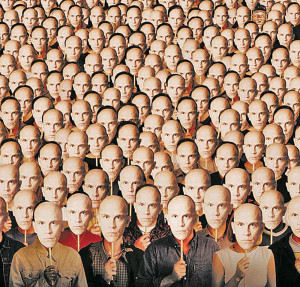What would Lynne Tillman do? Often the answer is crack a joke. These four very short pieces, often no more than a paragraph, are almost epigrams or koans. They are definitely comic. Here Lynne does for the essay what Lydia Davis has done for the short story – set it free. And the results are funny, disturbing – and true. The truth herein is one of life in New York, of art, of fame, of surreality…. All indeed, something to celebrate.
Let’s Vote on It
TOMPKINS SQUARE PARK was the site of a tree-planting ceremony in honor of Allen Ginsberg. Ginsberg lived on East Tenth Street, bordering the park, for 30 years before his death in 1997. I went, even though I was, and still am, ambivalent about him. Thirty people were there. One of the poets who organized the event took the mike. He started to talk about Ginsberg; the tree planted for him; Ginsberg’s name on a plaque; and the importance of Tompkins Square for the neighborhood. A woman standing on the sidelines screamed: “Allen would’ve hated this, he would’ve hated what’s happened to the park.” In 1989, the park was closed for more than a year, maybe two, after the City forcibly evicted squatters and homeless people from it. There was a terrible, violent confrontation, and, ever since it reopened, cleaned up and refurbished, the police surround the park every May Day, expecting trouble. The poet tried to continue, but the woman kept shouting, then demanded to speak at the mike. “Let her,” someone yelled. “Get her out of here,” someone else yelled. Quickly, the organizers decided we’d all vote on it: three minutes, yea or nay. She got them. I couldn’t stay and left thinking how democratic it all was, how right that a worthy ceremony turned into a fractious happening, an existential monument to Ginsberg. It was complicated and funny, too, like living inside a New York joke: “A Jew, an Irishman, and a black man walk into a bar. The bartender says: Is this a joke?”
~
The Litvaks Are Not Funny
THE FILM SHOWS at the Museum of Modern Art attract a strange audience. Very old people who come to all the shows tend to talk throughout the experimental work or leave. People drift in and out. The serious remain. Very big audiences become small ones. It’s a hard crowd to figure.
One night when I was there, before the start of the film, a young man leaped onto the stage and announced that he was an unemployed actor looking for a role in a movie. He pointed to his seat and urged anyone interested to contact him then and there. Smiling, he leaped from the stage and the audience applauded.
We became a more relaxed crowd and I remarked casually to the elderly women beside me, “New York is such a crazy place.”
Her answer was less casual. She replied: “Yes, that’s because of the Galiciani. The Litvaks are not funny.” She paused and continued: “The English are Jews. Gaelic is Hebrew but no one knew this until Pittman invented shorthand and then without the vowels it was clear that Gaelic and Hebrew were the same. The English are Jews.” Her hand waved in front of her and she said: “My daughter wrote the best art book ever written. It’s across the street at the Donnell Library. My husband invented radar. All the books are across the street.” I consider this and the lights dim.
~
Twee Kamers
It’s very difficult to find apartments in Amsterdam, an old and small city. Sidonie and her friend were trying to find a place to live and they placed an ad in the newspaper, giving my place of work to call. They asked if I would mind taking calls for them. I said I wouldn’t.
My Dutch was hardly adequate; it enabled me to buy food and panic when times called for it. They had advertised for two rooms. I knew two rooms to be twee kamers.
I was alone in the office when the telephone rang. A Dutch male voice asked, “Advertitie voor twee kamers?” Ya, I replied, not me (or may, as it would be pronounced in Dutch), my friends, twee persons voor twee kamers. I felt quite proud of myself, two people for two rooms. Aah, he said, twee persons. Ya, I said, do you have them? Twee kamers, he said. Ya, ya, I said. Slowly, and partially in English, he said, “I am holding my pemel.” Oh, ya, I said, thinking he might mean he was holding a pencil, not knowing the word for pencil in Dutch, though curious as to why he would tell me that at all. “Momentje,” he called out. I imagined he was writing something down and waited. “Ik kom,” he cried. I hung up.
~
Stars In Their Eyes: Fame is a Frame*
Life’s tough as a street-art puppeteer, but when Craig Schwartz (cunning John Cusack) starts a deadbeat day job in an office where the ceiling’s so low everyone has to bend over, he discovers a way out—a secret tunnel into the mind and body of John Malkovich (playing himself, sort of). Spike Jonze’s first feature Being John Malkovich renders identity as the playground and prison it is. When everyone wants to be known, rather than to try to know, celebrity is the pinnacle of success. To the star-obsessed, being known might mean not having to know yourself, and if you don’t like yourself, this must be freedom. Dropped into the body of someone else, though, might allow for the ironic discovery that others are just as limited as you are. I laugh every time I think of Cameron Diaz—so thoroughly unglamorous she’s a sight gag— in a cage with a monkey; and Malkovich at home halfnaked, his paunch smiling at the fantasy of celebrity perfection.

*(Published originally in Frieze magazine, #49, London: Fall 1999, p. 58.)



Так проходила жизнь каждого советского школьника: немножко воспоминаний